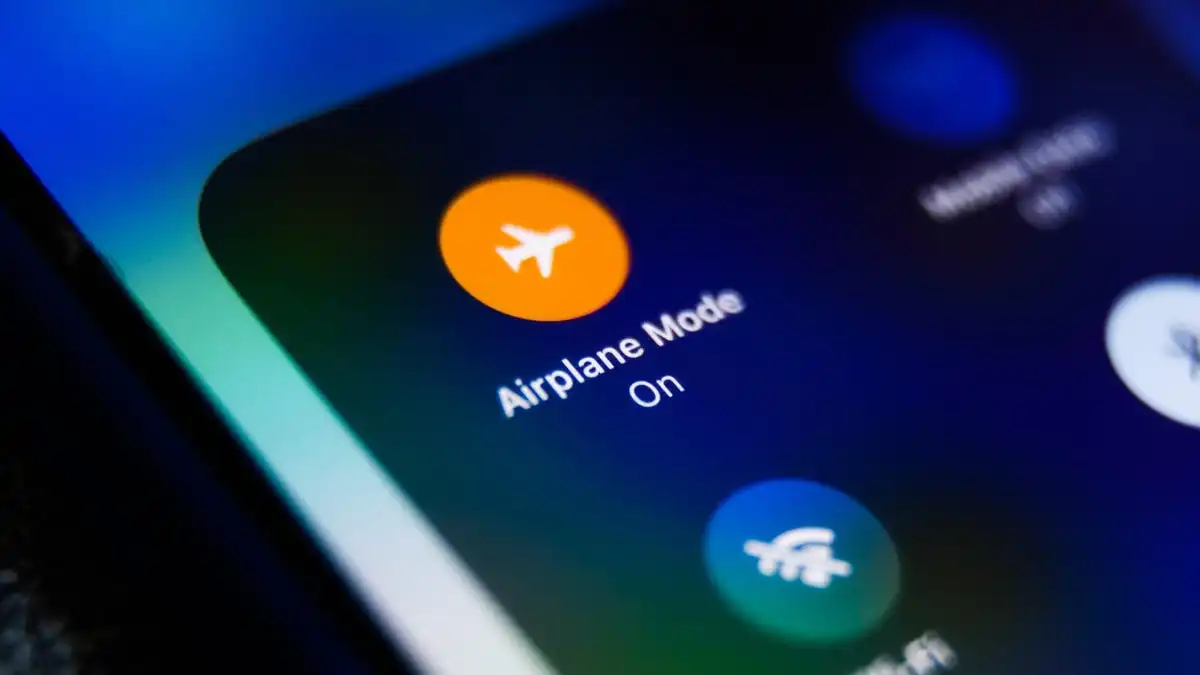- cross-posted to:
- technology@lemmy.world
- cross-posted to:
- technology@lemmy.world
I can still flummox this thing with something I bought at Radio Shack?
Here is an alternative Piped link(s):
https://piped.video/i1wwfycW5sg?feature=shared&t=175
Piped is a privacy-respecting open-source alternative frontend to YouTube.
I’m open-source; check me out at GitHub.
More importantly, you don’t need to be on an airplane to use airplane mode.
How to use WiFi in plane if you put your phone in airplane mode? nonsense.
My phone allows me to independently choose Wi-Fi and Bluetooth state separately from the cellular state.
When I turn on airplane mode it turns off everything but of course I can turn wifi on just after. But all the phones I have seen when you set in airplane mode it turns off cell wifi BT even nfc
Almost every android phone. Not sure about iPhone though.
It’s the same on iOS. They’re separate toggles.
iPhones don’t even turn wifi/bluetooth off when you toggle them specifically. They certainly don’t disconnect in airplane mode.
The quick wifi/bluetooth buttons are to disconnect temporarily when you’ve got a bad connection. Or if your husband started the car but you’re not in it, you’re just nearby. They’re not to turn the radios off.
Airplane mode is no longer about shutting down all wireless communication. It’s been for some time.
Now it’s shutting down the cellular connection only, wifi and bluetooth stay on.
I always have my phone on. No one can tell me to turn it off as it’s my right
All the comments about technical details and practical details…
Are we forgetting that when dealing with millions of people, plus bureaucracy, in a potential death risk, it’s worth being slow and cautious about relaxing former safety rules.
That was my understanding, that once upon a time it was legitimately feared that mobile phones could caused accidents (and thought they had indeed caused one). So, besides the other issues people have highlighted in the comments, to walk back from the safety rule of turn-them-off is a slow process.
Commercial air travel is not known for going, “ah, it’s probably fine, don’t worry;” except in the case of emergency exit door bolts.
Also, I’d like to add:
You don’t need to use airplane mode on airplanes
… Please do follow the rules, and do what the cabin crew ask you to do. Otherwise, even if you don’t directly endanger the plane, you make it harder for them to do their jobs and keep everyone safe.
Thanks for rendering my little private rebellion worthless. It’s all I had left.
I am not a very frequent flyer. In fact last time was over a year ago. even then, we were insteuctes to set lelectronics to flight mode only during take off and landing.
I used to turn Airplane Mode on during my LSD trips many years ago, pretty useful.
I haven’t heard drifting referred to as limited slip differential trips before, but that’s good that you aren’t texting and drifting.
That problem relates to landing an airplane with a 5G tower near the airport. Nothing to do with passenger phones.
And honestly it’s a faulty radio in the airplane. They shouldn’t be disrupted by 5G towers at all… but Boeing doesn’t want to pay for replacement parts and neither do the airlines.
I didn’t make any claims to the effect. In fact, I wanted to make it clear that even these worries over 5G towers aren’t really relevant or a reason to keep such a claim alive. There is no need to take my word for it. The FAA has already covered it.
I feel like this has been common knowledge. Airplane mode is more about “we don’t want some asshole talking to their client on the phone while we are trying to do the safety briefing and take off”
Uneducated writers thinking using phone during flight is the same thing as using phone on the ground. It’s not.
Phones won’t interfere with sensors and stuff on airplane. That much is true. However pilots need to communicate with all kinds of airport staff over FM radio and there, since it’s an analogue signal, phones can cause that familiar disruption. It won’t destroy equipment, but you will annoy pilots and might prolong departure time. Same thing when landing, you are coming from no signal zone and all of the sudden 100 phones starts talking at the same time when pilot is receiving instructions from the airport.
This is why you can talk during flight, but not takeoff.
Last time I flew, there was no signal at all while flying. not even GPS!
There was GPS signal, it’s just by design that chips are not allowed to lock at above certain speed to prevent military use. But even if there’s no signal, mobile phone will try to find tower. If it doesn’t find one it will try increasing transmission power.
But even if there’s no signal, mobile phone will try to find tower. If it doesn’t find one it will try increasing transmission power.
Thus draining the phone’s battery much faster.
Same thing happens if you are camping in a remote location with weak or non-existent coverage.
Yup. Although it’s been a while since I found a place without mobile signal for camping. This planet is getting crowded.
That makes sense! Thanks
Next time you’re on a flight, download a GPS speedometer app and launch it right before takeoff. You’ll notice that it’ll accurately measure the plane’s speed up to around 500 MPH, before it suddenly stops giving you a speed readout.
Like the other person said, this is to prevent your average dude building a guided missile using an old phone they have lying around.
It’s a built-in security of the protocol. For accurate speed measurement device would need access to L2 frequencies, which carry encrypted data used for additional corrections, faster calculations, atmospheric conditions, etc. One can certainly get a location tracked through phone, but it’s not solely though GPS, it’s most likely combination of other positioning systems.
deleted by creator
You are welcome. Although, like I said in other reply, speed is not the only limiting factor. It just makes it harder to find location. There are number of other things.
What? Every smartphone I can remember owning has gotten a GPS signal if I hold it up to the window. Plenty of planes have GPS on board too. If there is a speed lockout, a 737 isn’t enough to break that threshold.
Speed limit is indeed above speed that 737 can fly (see addendum), but it’s not only reason why GPS sometimes doesn’t lock. On the plane your phone doesn’t get assisted GPS, where rough location calculation is based on ground data like WIFI networks and GSM towers, so time to first fix takes significantly longer because your phone only has access to L1 frequencies. Since it takes a while, 30s for entire satellite message to be transmitted, it’s coordinates and the like, and there’s no help from ground stations for crude calculation combined with speed of the plane it all ends up contributing to a significantly longer time to first fix or perhaps even problematic fix in the first place.
So all in all, speed contributes to the problem. Yes signal was present at all times. And no, speed is not the sole factor but contributes a lot. GPS chips have improved quite a bit over the time so some old devices will definitely have a problem finding location on plane. Newer ones won’t, especially considering they have access to other networks like Galileo, GLONASS and BeiDou.
All GPS receivers capable of functioning above 60,000 ft (18 km) above sea level and 1,000 kn (500 m/s; 2,000 km/h; 1,000 mph), or designed or modified for use with unmanned missiles and aircraft, are classified as munitions (weapons)—which means they require State Department export licenses.[126] This rule applies even to otherwise purely civilian units that only receive the L1 frequency and the C/A (Coarse/Acquisition) code.
Edit: What airplanes have on board, is access to different frequency which your device doesn’t. It’s not comparable.
Last time I flew, there was no signal at all while flying.
There’s a number of factors that lead to that.
-
The cell base station antennas have a relatively narrow vertical beamwidth and are typically aimed a few degrees below horizontal. (Aircraft tend not to operate at that altitude)
-
usable range of each cell base stations is typically <50 km.
-
Cell base stations are optimized for communicating with mobiles moving less than 90km/h.
Given all that, if you happen to get a signal, you’ll be handing off between towers far too fast and too frequently for the network to reliably deal with.
-
There’s no way there was no GPS, maybe your phone was trying to base your location with antennas and not GPS
I put my phone in airplane mode if for no other reason than if it’s constantly trying to connect to a signal or Wi-Fi, it drains the battery way faster.
Or that. Whatever the reason is, if one is being asked to disable phone, then disable it. There’s no reason to be an smartass and cause issues.
That disruption is from a 2G/GSM handset. Those networks were turned off a decade ago.
Pilot here. Still on the A320 series it’s obligatory to turn off the electrical devices for low visibility approaches (ILS Cat2/3) as aircraft’s navigational systems are not protected (at least certified) against RF interference.
Stupid article.
General observation.
As people lose more and more real freedoms [lower real wages, more crowded roads, small retail stores swallowed up by mega-corps] they cling to false freedoms. They will keep those phones on, because it’s their right to, dammit!
HowardBealeRant.avi
As of Jan 31, 2024 any planes still not hardened their altimeters to meet group 4 performance are restricted from flying auto land, I/II ILS ; and for the most part the airlines still flying them aren’t using those planes in US airspace. It doesn’t mean that there aren’t any flying just that when they are they’re restricted by the FAA as to how they can operate.
Many more planes outside of US airspace, and plenty of those are rather older than 2024.
GSM is still very much alive in many countries.
Can confirm. I own a pair of noise canceling earmuffs (meant for sport shooting; my dad was into guns). They’re completely unshielded so I can pick up interference from all sorts of signals. It’s fun to switch my phone between different networks to hear what 2G/3G/LTE/5G sounds like. I can even hear WiFi and find the dead spots in my house.
Point I’m making is that GSM is still sticking around here as a backup so when I drop my phone to 2G it sounds exactly the same as it does in this video.
3G has been turned off in a lot of places, but 2G is still very much used globally. It’s still the last fallback for phones to maintain basic texting and calling functionality. In many places emergency services also use it for e.g. emergency information via text message.
Cool, I never did anyways. I knew it was horseshit to begin with and was just info being fed from uneducated tech people to more uneducated tech people.
I think it was just more protecting against the one in a billion chance of interference that could potentially take down a plane full of people. Why risk it if the alternative is something as basic as tapping a setting on your phone during takeoff and landing?
Same, there’s not even a battery saving aspect to it anymore now that planes have at least USB ports to charge from if not full blown outlets lol
You are one of those people who should be forced to do something very sensitive with high responsibility and have someone sit next to you and slap you randomly in the face while expecting you to do your job. That’s essentially the same thing you are doing to pilots while they try to keep your ass safe and alive.
Then why flight attendant says “switch your devices to flight mode”? It was a week ago in domestic european flight.
They usually only ask you to do so for take off and landing. Also based on experience from a European flight
Last time i forgot and the phone connected to “aeromobile”. Would have cost me a packet if i had left roaming data on
Airplane mode is a blessing. If the OS is trustworthy (i.e. FOSS Android) then it actually works, it turns off that crappy unprivate cell connection and you have anonymous Wifi only.
It saves battery and you can use your phone without anyone being able to track you easily.
Btw Google hides the GPS quicksettings toggle for a reason, edit the shortcuts and add it.
… What? You think WiFi is anonymous?
If you randomize your Mac address (which is default on GrapheneOS and Fedora now) you are pretty anonymous to the wifi network.
Of course websites see where you are, they always do that. Use Tor or a VPN.
It can sometimes triangulate you better than the cell towers.
WiFi isn’t as safe as they apparently think it is lol
If the SSID you connect to is unique enough, there’s a site that can literally pinpoint your location. If you have any other SSIDs around you, it’s basically guaranteed. That’s why there’s a bunch of apps that log the SSIDs around you, to get your location without having to ask.
That’s not even considering the entire rest of WiFi that’s not anonymous














